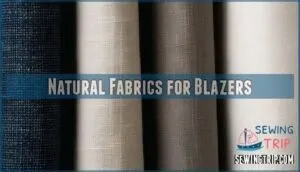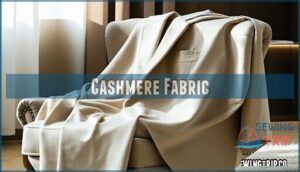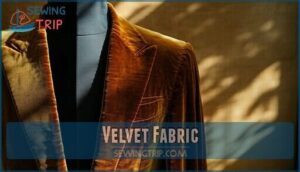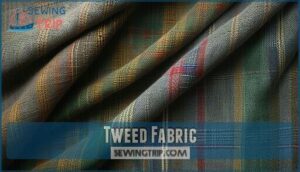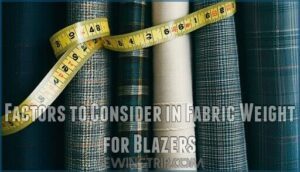This site is supported by our readers. We may earn a commission, at no cost to you, if you purchase through links.
 If you’re wondering what type of fabric is used for blazers, you’ve got plenty of options, each with its own personality.
If you’re wondering what type of fabric is used for blazers, you’ve got plenty of options, each with its own personality.
Wool stands tall for year-round comfort, while cotton and linen feel lighter, perfect for summer.
Polyester blends keep wrinkles at bay, cashmere adds luxury, and tweed lends an academic flair.
Some days, you might even spot velvet blazers, making you feel like a rock star at a fancy dinner.
Every fabric offers a different blend of breathability, stretch, and sophistication, so there’s a perfect match for every vibe.
Want to know which fabric truly fits your lifestyle? Stick around.
Table Of Contents
- Key Takeaways
- Types of Fabric for Blazers
- Natural Fabrics for Blazers
- Synthetic Fabrics for Blazers
- Specialty Fabrics for Blazers
- Suitable Fabrics for Summer Blazers
- Suitable Fabrics for Winter Blazers
- Factors to Consider in Fabric Weight for Blazers
- Lining Fabric for Blazers
- How Much Fabric is Needed for a Blazer?
- Choosing The Best Fabric for Your Blazers
- Frequently Asked Questions (FAQs)
- Conclusion
Key Takeaways
- Wool stands as the gold standard – You’ll get year-round versatility, natural breathability, and excellent durability that maintains shape and resists wrinkles better than synthetic alternatives.
- Choose fabric based on season and occasion – You’ll want lightweight options like linen and cotton for summer heat, while heavier materials like tweed and cashmere work best for winter warmth and formal events.
- Natural fabrics offer superior comfort – You’ll find wool, cotton, and linen provide better breathability and moisture-wicking compared to synthetic blends, though polyester offers easier care and wrinkle resistance.
- Fabric weight determines performance – You’ll need lightweight fabrics (under 270GSM) for summer comfort, midweight (8-10oz) for year-round wear, and heavyweight (340+ GSM) for winter warmth and structured appearance.
Types of Fabric for Blazers
Starting your search for the best blazer material, you’ll find that each blazer fabric offers a unique mix of fabric durability, weave density, and drape qualities.
Wool blazer fabric stands strong for cooler seasons, while linen blazer cloth and crisp cotton keep you cool in the heat.
Choose wool for warmth, linen and cotton for summer’s heat—each fabric shapes your blazer’s performance.
Pay attention to fiber content and fabric cost—these factors shape comfort and style, blending classic blazer cloth types guarantees your wardrobe works overtime, so you’re ready for any occasion with confidence.
Natural Fabrics for Blazers
When you’re choosing a blazer, natural fabrics like wool, cotton, and linen give you a balance of comfort, breathability, and style.
You’ll notice these materials adapt well to different seasons, making them practical for everyday wear, with a focus on breathability.
Wool Fabric
Wool blazer fabric is the gold standard when you want something durable, comfortable, and sharp.
Merino wool stands out for its softness and itch-free feel, while worsted wool brings extra structure and polish.
Thanks to excellent wool insulation, you’ll stay warm but not stuffy. Wool drape flatters the body, and its lasting quality means a blazer that’s always ready for action.
Consider exploring available wool options for your next project.
Cotton Fabric
If you want a breathable blazer that’s laid-back yet sharp, cotton fabric should be on your radar.
Cotton properties—like easy care and a soft hand—make cotton blazers summer staples.
This cotton blazer material comes in casual cotton weaves, blends, and solids that feel light on hot days.
No fuss for maintenance, just toss it in the wash.
For a crisp look, pair with jeans or chinos.
You can even find a great summer cotton blazer for any occasion.
For a crisp look, pair with jeans or chinos.
- Choose lighter cotton blends for durability.
Linen Fabric
On sweltering summer days, you’ll really appreciate linen’s cool touch. Linen blazer fabrics breathe better than most, making them king among breathable fabrics.
Linen vs. cotton? Linen wins on airflow, though cotton edges out for absorbency and durability. With the right care, linen holds up well season after season.
Here’s how feelings stack up:
———————:
————–:
——————:
Let linen’s personality shine when picking fabric types, and remember that linen wrinkles are part of its relaxed authority.
Synthetic Fabrics for Blazers
When you want durability without breaking the bank, synthetic fabrics offer practical solutions for your blazer collection.
These man-made materials combine affordability with performance features like wrinkle resistance and easy care.
Polyester Blend Fabric
Switching gears from natural fibers, let’s talk polyester blends. You get a polyester blazer that’s smart, easy to keep crisp, and friendly on your wallet.
Poly blend fabrics, mixed with natural or synthetic fibers, give you stellar wrinkle resistance and shape retention that stand up to daily wear. Don’t lose your cool—polyester blends are wrinkle-resistant, durable, and budget-minded.
Many retailers offer a polyester blend blazer.
- Wrinkle Resistance
- Shape Retention
- Affordable Blends
- Follow Care Instructions
Just remember: stick to the care label for best results and long-lasting style.
Viscose Fabric
Sometimes, the soft drape of a blazer turns heads before you even walk in. That’s all down to viscose—a semi-synthetic fiber known for its silky sheen and comfy, lightweight feel.
You’ll find viscose blends in many modern blazers, making them ideal for summer thanks to their breathability. Just remember, viscose durability isn’t on par with wool, so be gentle—cold water wash, hang dry, and you’ll avoid shrinkage.
Sustainability matters? Viscose is more eco-friendly than many synthetic fibers, yet it still delivers a professional look and smooth lining fabric. Understanding the properties of synthetic fabrics helps in making informed choices.
Here’s a quick comparison:
| Feature | Viscose | Wool | Polyester |
|---|---|---|---|
| Breathability | High | Medium-High | Low |
| Durability | Moderate | High | High |
| Care | Gentle wash/dry | Dry clean only | Easy care |
Specialty Fabrics for Blazers
You’ll find luxury blazer options when you choose specialty fabrics that stand out from everyday materials.
These premium choices—cashmere, velvet, and tweed—offer unique textures and sophisticated appeal that elevate any wardrobe.
Cashmere Fabric
A cashmere blazer feels like wearing a cloud—soft, warm, and elegant.
Thanks to careful cashmere sourcing, this luxury fabric stands out among blazer fabrics for its featherlight touch and impressive insulation.
While it’s pricier and more delicate than wool, its superior comfort is tough to match.
To boost cashmere durability, treat it with care: gentle hand washing helps prevent pilling.
If pure cashmere strains your wallet, cashmere blends or cashmere alternatives maintain some luxury without the full price tag, offering a more affordable option.
Velvet Fabric
Among formal blazer fabrics, velvet blazers always steal the spotlight with their signature velvet nap and natural sheen.
Whether you choose classic solid velvet or bold crushed velvet, this material brings a touch of history and luxury to special occasions.
Remember to brush off lint or pet hair before wearing for crisp style, and opting for tencel or rayon lining adds comfort.
To prevent puckering, consider using a longer stitch length, and care for your velvet by following instructions closely—velvet care keeps the blazer looking sophisticated year after year, ensuring a long-lasting appearance.
Tweed Fabric
Tweed blazer fabric offers unmatched character and longevity for your wardrobe.
This woolen fabric features complex tweed weaving techniques that create distinctive tweed patterns and rich tweed colors.
Understanding tweed history reveals its Scottish Highland origins, where durability mattered most.
- Visual appeal: The nubby texture adds depth and sophistication to any outfit
- Versatile styling: Works equally well with jeans for casual looks or dress pants for formal occasions
- Investment piece: Tweed durability guarantees your blazer will outlast trends and serve you for decades
Among blazer cloth types, tweed stands out for combining heritage craftsmanship with modern style sensibilities.
Suitable Fabrics for Summer Blazers
Summer blazers need fabrics that beat the heat while keeping you looking sharp. Linen stands out as the champion choice – its open weave creates maximum airflow and wicks moisture like a pro.
You’ll stay 30% cooler compared to synthetic alternatives, plus linen gets softer with every wash. Cotton weaves offer another stellar option. Seersucker blazers bring that classic southern charm with their puckered texture that creates air pockets.
Cotton blends around 8-11 ounces hit the sweet spot between structure and breathability. Don’t overlook tropical wool either. This lightweight blazer fabric regulates temperature better than you’d expect from wool.
Linen blends combining cotton-linen give you durability without sacrificing airflow. One popular choice is breathable wool fabric, known for its natural breathability and resilience. Performance fabrics are game-changers for active summer wear.
These synthetic blends offer stretch, wrinkle-resistance, and machine-washable convenience while maximizing ventilation. Your summer blazers should feel barely-there yet look polished.
Choose unlined or half-lined options to boost breathability even more.
Suitable Fabrics for Winter Blazers
When summer ends, winter blazers step in to provide both warmth and sophistication. You’ll want to reach for heavyweight fabrics that trap body heat while maintaining a polished appearance.
Wool insulation stands as your best friend during cold months. Worsted wool creates structured blazers that resist wrinkles, while a flannel blazer offers softer comfort with excellent thermal properties. Cashmere delivers luxury warmth that’s eight times more insulating than regular wool, perfect for upscale occasions.
Tweed warmth comes from its dense weave and heritage craftsmanship. Originally designed for Scottish hunters, this woolen fabric naturally repels moisture while providing serious heat retention. The textured surface adds visual interest to winter styling.
Velvet elegance brings both thermal benefits and formal appeal. Its dense pile traps air effectively, creating a barrier against cold while adding sophisticated texture. Whether cotton or polyester-based, velvet blazers work beautifully for evening events.
Choose darker shades like navy or charcoal for winter blazers—they’re forgiving and versatile for professional settings. For unparalleled wind-proofing, consider leather winter jackets.
Factors to Consider in Fabric Weight for Blazers
When you’re shopping for a blazer, fabric weight becomes your secret weapon for getting the perfect fit and comfort.
The weight determines everything from how the blazer drapes on your body to whether you’ll be sweating through a summer meeting or shivering at a winter event, which is crucial for comfort.
Importance of Fabric Weight
Understanding blazer fabrics goes beyond just material choice—fabric weight shapes everything from comfort to style.
Measured in GSM (grams per square meter), this specification determines how your blazer performs across different situations.
Here’s why fabric weight matters for your blazer selection:
- Drape and Structure – Heavier worsted wool (300+ GSM) creates sharp lines, while lightweight fabrics offer softer silhouettes
- Seasonal Suitability – Under 270 GSM works for summer, 8-10oz handles year-round wear
- Blazer Durability – Higher fabric GSM typically means longer-lasting garments that resist wear
- Comfort Levels – Lighter weights improve breathability but may wrinkle more easily
- Lining Fabric compatibility varies with base weight for efficient construction
Smart fabric weight selection guarantees your blazer serves its intended purpose effectively.
Best Fabric for Seasons
Choosing the right fabric weight for different seasons makes all the difference in your comfort and style.
For summer blazers, lightweight options under 270GSM keep you cool and breathable.
Winter blazers need heavyweight fabrics above 340GSM for warmth and structure.
Midweight fabrics (8-10oz) offer year-round versatility, balancing climate considerations with occasion appropriateness for ideal layering options.
Different Fabric Characteristics
Fabric characteristics directly impact your blazer’s performance and appearance.
Weave density affects durability—tighter weaves resist wear and creasing better than loose ones.
Fiber content determines drape quality, with natural fibers offering superior breathability.
Lightweight fabrics provide softer drape but less structure, while heavyweight options deliver formal appearance and lasting shape.
Consider seasonal suitability when selecting blazer fabrics for ideal comfort.
Lining Fabric for Blazers
Beyond fabric weight considerations, the interior of your blazer deserves equal attention.
Lining materials play a vital role in comfort, durability, and overall wearing experience.
Silk lining stands as the premium choice, offering exceptional breathability factors and luxurious comfort qualities.
It’s smooth against skin and naturally regulates temperature, though it comes with higher cost comparison figures.
Rayon lining provides an excellent middle ground – this synthetic fiber mimics silk’s softness while maintaining better durability aspects at a fraction of the price.
Polyester dominates ready-to-wear blazers due to its wrinkle resistance and affordability, but lacks breathability compared to natural alternatives.
Bemberg rayon offers superior moisture-wicking properties with low static buildup, making it popular in higher-end garments.
For partial linings, viscose and acetate provide smooth finishes with moderate durability.
Cotton lining fabric maximizes breathability for summer blazers but adds bulk.
Your choice depends on climate, budget, and intended use – silk and rayon excel in warm weather, while polyester handles frequent wear better.
How Much Fabric is Needed for a Blazer?
Now that you’ve selected quality lining fabric, calculating the right fabric yardage becomes your next priority. Getting this calculation right means the difference between a perfectly customized blazer and costly fabric shortages.
Size Matters for fabric calculation. You’ll typically need:
- Small: 2 yards
- Medium: 2.5 yards
- Large: 3 yards
Several Yardage Factors affect your blazer fabrics requirements. Pattern complexity increases fabric needs – plaids require extra material for matching, while solid colors offer more flexibility. Fabric width impacts calculations too; 60-inch wide fabric proves more economical than narrower options.
Waste Minimization strategies include:
- Adding 0.25-0.5 yards for shrinkage and fabric flaws
- Purchasing extra fabric for future repairs or alterations
- Choosing fabric weight appropriate for your blazer’s intended structure
Double-breasted styles demand 2.75-3 yards, while fitted designs may need less. Your fabric choice influences yardage – thicker materials like tweed require more due to inflexible drape.
Always round up when purchasing. That extra quarter-yard could save your project when pattern matching demands precision or fabric flaws appear unexpectedly.
Choosing The Best Fabric for Your Blazers
You’ll need to match your blazer fabric to your lifestyle and the occasions you’ll wear it. The right choice depends on factors like climate, formality requirements, and personal comfort preferences.
Wool Vs. Cotton: Which is Best?
When comparing wool vs. cotton for blazers, wool wins for formal occasions with superior durability and climate suitability in cooler weather.
Cotton excels for casual wear with lower cost and easier care requirements.
Wool’s fabric composition offers better shape retention, while cotton provides comfort in warm conditions.
Your fabric choice depends on intended use and budget, considering factors like durability to make an informed decision.
Summer Blazers: Breathable Options
Three key fabrics excel for summer blazers when you need breathability without sacrificing style.
Linen benefits include unmatched ventilation and natural cooling, while cotton weaves offer structured comfort.
Silk blends add luxury with moisture-wicking properties, and lightweight synthetics provide wrinkle resistance.
- Linen: Natural fibers create exceptional airflow for warm weather comfort
- Cotton: Lightweight weaves balance structure with breathability perfectly
- Fresco Blazers: Specialized wool weaves designed for hot climates
- Silk Blends: Smooth texture with natural temperature regulation properties
Women’s Blazer Fabrics
While breathable options work wonders for summer, women’s blazers require specific considerations that go beyond seasonal comfort.
Fabric drape plays a vital role in creating those coveted feminine silhouettes that flatter your figure perfectly.
Modern blends have revolutionized womens blazers, offering you sophisticated options that maintain blazer structure without sacrificing comfort.
You’ll find these materials deliver exceptional occasion suitability for both boardroom meetings and weekend brunches.
Here are the top blazer fabrics that’ll elevate your wardrobe:
- Wool – Provides classic structure and wrinkle resistance for professional settings
- Silk blazer fabric – Creates luxurious drape with natural sheen for special occasions
- Cotton blends – Offer breathability and easy care for everyday wear
- Velvet blazer material – Delivers rich texture and elegance for evening events
When selecting rayon blazer options, you’re choosing versatility that adapts to your lifestyle.
These fabrics combine the best of natural fibers with synthetic durability, giving you blazers that look polished while feeling comfortable throughout your busy day.
Frequently Asked Questions (FAQs)
What fabrics make a blazer?
You’ll find blazers crafted from wool, cotton, linen, cashmere, and polyester blends.
Wool remains the gold standard for its natural drape and breathability, while cotton and linen work perfectly for summer’s heat.
Which Blazer fabric is best?
If you want a blazer that won’t let you down year-round, wool’s your best bet.
It breathes well, keeps its shape, and handles a busy schedule.
For summer, reach for linen or cotton to keep cool.
Why is wool a good fabric for a blazer?
Wool’s natural properties make it perfect for your blazer needs.
It breathes well, absorbs moisture, insulates effectively, and maintains its shape.
You’ll find wool drapes beautifully and resists wrinkles better than synthetic alternatives, ensuring long-lasting style.
It has several benefits that make it a great choice for clothing, including its ability to breathe well.
What is a blazer made of?
Blazers are typically crafted from wool, which provides natural breathability and structure.
You’ll also find cotton, linen, cashmere, tweed, velvet, and polyester blends, each offering different weights, textures, and seasonal suitability.
How do I choose the right Blazer fabric?
Consider your lifestyle, occasion, and climate when selecting blazer fabric. Wool works best for year-round versatility and formal events, while cotton and linen suit casual, warm-weather wear perfectly.
What is the best fabric for a warm weather Blazer?
You’ll want lightweight, breathable fabrics for warm weather blazers.
Linen offers unmatched airflow and texture, while cotton provides coolness and casual comfort.
Lightweight wool and fresco fabric also work excellently for hot climates.
Which type of fabric is best for a blazer?
Like knights choosing chainmail for battle, you’ll want wool as your go-to fabric. It’s breathable, durable, and works year-round. For summer, try linen or cotton for comfort.
What fabric should blazers be made of?
You’ll want wool as your go-to choice since it’s breathable, durable, and works year-round. Cotton and linen work great for summer, while cashmere adds luxury for special occasions.
What is the best fabric for blazers?
Wool stands as your best choice, offering natural breathability, moisture-wicking, and year-round versatility. You’ll find merino wool particularly soft, while worsted wool provides formal structure and durability.
What kind of fabric is used to make blazers?
Like choosing armor for battle, selecting blazer fabric demands strategic thinking.
You’ll encounter wool as the cornerstone—breathable, durable, and naturally elegant.
Cotton offers lightweight comfort for warmer days, while linen provides unmatched breathability with distinctive texture.
Conclusion
Like choosing the perfect sword for battle, selecting what type of fabric is used for blazers requires understanding your needs and environment.
Whether you’re drawn to wool’s versatility, cotton’s breathability, or cashmere’s luxury, each material serves a specific purpose.
Consider your climate, lifestyle, and personal style when making your choice.
Summer calls for lighter fabrics like linen and cotton, while winter welcomes heavier options like tweed and wool blends.
The right fabric transforms any blazer into your signature piece.
- https://en.wikipedia.org/wiki/Blazer
- https://sewport.com/fabrics-directory/flannel-fabric
- https://www.nordstrom.com/browse/content/blog/most-breathable-fabrics
- https://www.trutailorcocustomsuits.com/blogs/news/the-best-fabrics-for-summer-suits-and-sports-jackets-a-guide-to-staying-cool-and-stylish
- https://www.reddit.com/r/NavyBlazer/comments/fd8obe/when_its_too_hot_to_wear_a_wool_blazer_what_does/

